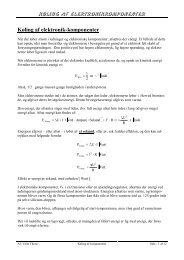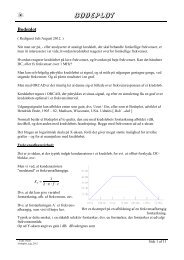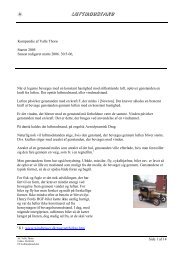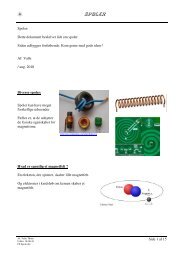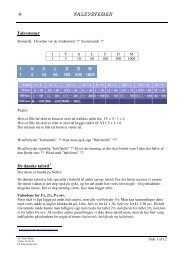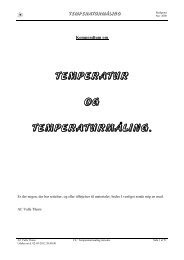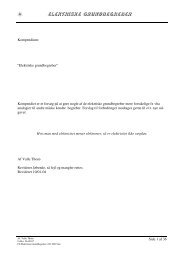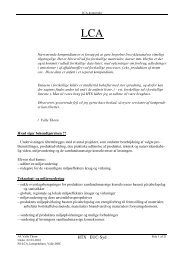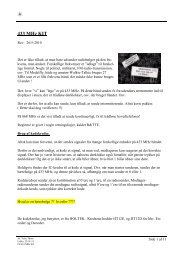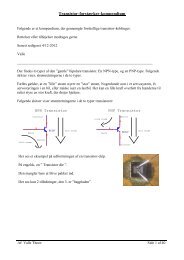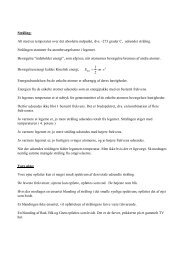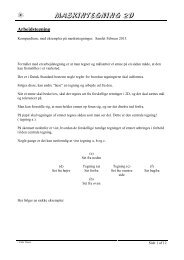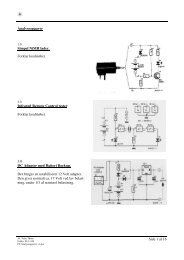Busser - Valle´s Bedste Hjemmeside.
Busser - Valle´s Bedste Hjemmeside.
Busser - Valle´s Bedste Hjemmeside.
You also want an ePaper? Increase the reach of your titles
YUMPU automatically turns print PDFs into web optimized ePapers that Google loves.
<strong>Busser</strong><br />
Current Address Read<br />
Current address read will read the data at the current address of the EEPROM's internal<br />
address pointer. If the previous read was at location "n", the next current address read would<br />
access data from address "n+1". A control byte with R/W set to logic 1 (READ) is sent by the<br />
Master, the Master receives the slave's ACK, the Master gets the DATA and issues a STOP<br />
condition without generating an ACK. This is called a "NACK".<br />
Random Read<br />
Random read will access data from a specified EEPROM address. Random read is very similar<br />
to byte write with one exception: where the data is sent in Byte Write, Random Read sends a<br />
START condition with R/W set to logic 1 (READ), receives the ACK and the data, then issues a<br />
NACK (a STOP condition without sending an ACK).<br />
Følgende er fra http://www.robot-electronics.co.uk/acatalog/I2C_Tutorial.html er gaflet:<br />
The I2C Physical Protocol<br />
When the master (your controller) wishes to talk to a slave (our CMPS03 for example) it begins by issuing a start sequence on<br />
the I2C bus. A start sequence is one of two special sequences defined for the I2C bus, the other being the stop sequence. The<br />
start sequence and stop sequence are special in that these are the only places where the SDA (data line) is allowed to change<br />
while the SCL (clock line) is high. When data is being transferred, SDA must remain stable and not change whilst SCL is high.<br />
The start and stop sequences mark the beginning and end of a transaction with the slave device.<br />
Data is transferred in sequences of 8 bits. The bits are placed on the SDA line starting with the MSB (Most Significant Bit). The<br />
SCL line is then pulsed high, then low. Remember that the chip cannot really drive the line high, it simply "lets go" of it and the<br />
resistor actually pulls it high. For every 8 bits transferred, the device receiving the data sends back an acknowledge bit, so there<br />
are actually 9 SCL clock pulses to transfer each 8 bit byte of data. If the receiving device sends back a low ACK bit, then it has<br />
received the data and is ready to accept another byte. If it sends back a high then it is indicating it cannot accept any further<br />
data and the master should terminate the transfer by sending a stop sequence.<br />
How fast?<br />
The standard clock (SCL) speed for I2C up to 100KHz. Philips do define faster speeds: Fast mode, which is up to 400KHz and<br />
High Speed mode which is up to 3.4MHz. All of our modules are designed to work at up to 100KHz. We have tested our<br />
modules up to 1MHz but this needs a small delay of a few uS between each byte transferred. In practical robots, we have never<br />
had any need to use high SCL speeds. Keep SCL at or below 100KHz and then forget about it.<br />
I2C Device Addressing<br />
All I2C addresses are either 7 bits or 10 bits. The use of 10 bit addresses is rare and is not covered here. All of our modules and<br />
the common chips you will use will have 7 bit addresses. This means that you can have up to 128 devices on the I2C bus, since<br />
a 7bit number can be from 0 to 127. When sending out the 7 bit address, we still always send 8 bits. The extra bit is used to<br />
inform the slave if the master is writing to it or reading from it. If the bit is zero the master is writing to the slave. If the bit is 1 the<br />
master is reading from the slave. The 7 bit address is placed in the upper 7 bits of the byte and the Read/Write (R/W) bit is in<br />
the LSB (Least Significant Bit).<br />
/: Valle Thorø<br />
Side 17 af 43



